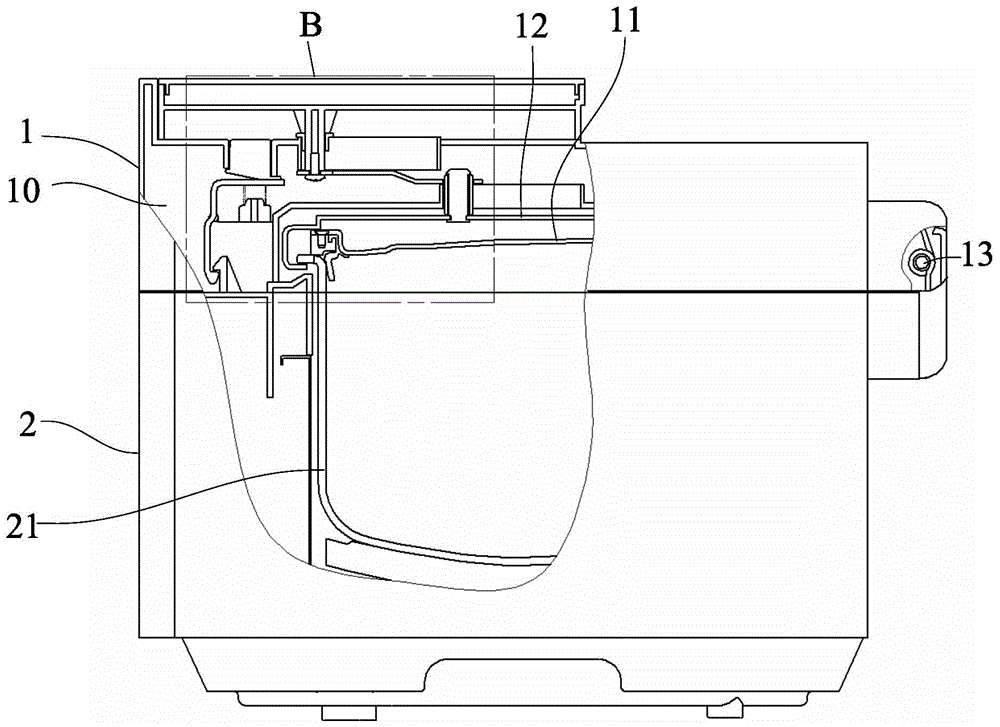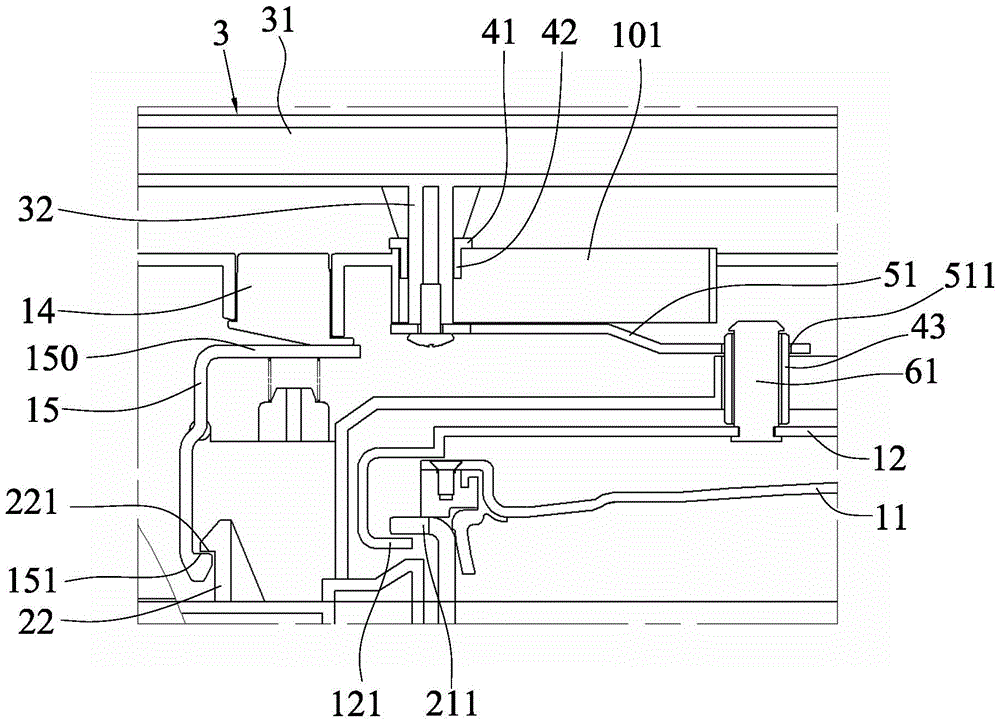a cooking utensil
A technology for cooking utensils and operating parts, which is applied to the cover of cooking utensils and other directions, and can solve the problems of laborious operation, limited space for users to operate, and unclear directions for opening or locking the cover.
- Summary
- Abstract
- Description
- Claims
- Application Information
AI Technical Summary
Problems solved by technology
Method used
Image
Examples
Embodiment 1
[0092] refer to Figure 1-4 , the cooking utensil of the present embodiment includes a body 2 and a cover 1, the body 2 includes an inner container 21 (also referred to as an inner pot or a pot by those skilled in the art) contained therein, and the cover 1 includes an outer cover 10. Inner cover 11, lock ring 12 arranged between the outer cover 10 and the inner cover 11 and rotatable relative to the inner cover 11, one end of the outer cover 10 is on the side of the main body 2 through the hinge mechanism 13, so that the cover 1 can be opposite to the main body 2 to flip. At least two first lock teeth 211 are provided on the body 2 , and the first lock teeth 211 can be formed on the outer edge of the mouth of the inner container 21 , or can be directly formed on the upper end surface of the body 2 . When the lock ring 12 and the inner cover 11 are set at the same time, the lock ring 12 is used as a locking member, and at least two second lock teeth 121 are arranged on the ed...
Embodiment 2
[0111] refer to Figure 5 , 6 , the cooking utensil described in the present embodiment is substantially the same as that of the first embodiment, the difference is that the active part of the transmission mechanism of the present embodiment includes a first connecting rod 52, and the outer teeth 621 are arranged on the passive part 62, and the locking ring 12 is opposite One side of the passive member 62 is partially provided with internal teeth 122 . One end of the first connecting rod 52 is rotatably connected to the operating member 3, the passive member 62 is rotatably connected to the cover body 1 around the second axis O2, and the passive member 62 is rotatably connected to the other end of the first connecting rod 52 around the third axis O3. , the second axis O2 and the third axis O3 do not coincide. Wherein, the second axis O2 is a fixed axis, and the third axis O3 is a moving axis.
[0112] refer to Image 6 , when the operating part 3 moves from the first posit...
Embodiment 3
[0117] refer to Figure 7 The cooking utensil described in this embodiment is substantially the same as that in Embodiment 1, the difference is that: the active part of the transmission mechanism in this embodiment includes a first rack 53 fixedly connected with the operation 3, and the passive part includes a The locking member is fixedly connected to a first gear 63 that rotates coaxially, and the first rack 53 is meshed with the first gear 63 . Wherein the first gear 63 and the lock ring 12 can be connected by some radial connecting rods, the first gear 63 is located at the center of the lock ring 12, and is coaxial with the lock ring 12, and the rotation of the first gear 63 can drive the lock ring 12 turn together.
[0118] When the operating member 3 moves from the first position to the second position, the linear motion of the first rack 53 drives the first gear 63 to rotate, and the rotation of the first gear 63 drives the locking ring to rotate together, so that the ...
PUM
 Login to View More
Login to View More Abstract
Description
Claims
Application Information
 Login to View More
Login to View More - R&D
- Intellectual Property
- Life Sciences
- Materials
- Tech Scout
- Unparalleled Data Quality
- Higher Quality Content
- 60% Fewer Hallucinations
Browse by: Latest US Patents, China's latest patents, Technical Efficacy Thesaurus, Application Domain, Technology Topic, Popular Technical Reports.
© 2025 PatSnap. All rights reserved.Legal|Privacy policy|Modern Slavery Act Transparency Statement|Sitemap|About US| Contact US: help@patsnap.com



